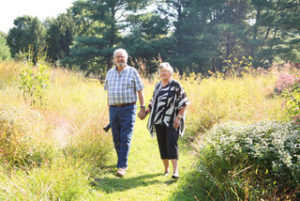Vol. 21 Issue 1, Spring 2016
By Nan McCarry

Enjoying the fruits of their labor
Photo by Ann Garvey
Sometimes people ask, “Why don’t I see any birds? I put up a bird feeder.”
In this issue, we read about the sounds of nature. How can we bring these seasonal sounds to our own backyards? The answer lies in the garden: Our gardening practices can encourage birds, frogs, and other wildlife into our yards.
A study recounted in Conservation Magazine found that trees were far more important than bird feeders in supporting bird diversity. In fact, there was “no statistical relationship between using [bird feeders] and having lots of birds.” A mixture of deciduous and evergreen trees creates a more complex habitat than lawns. Vertical diversity – trees and shrubs at different layers in the canopy – makes for more bird diversity. Birds rely on enormous quantities of caterpillars for their young. Native trees support lots of different caterpillar species, with oaks supporting the most of all. You can find lists of the trees that are the best for supporting caterpillars in Doug Tallamy’s Bringing Nature Home and also in the Habitat Herald archives on Loudoun Wildlife Conservancy’s web page. Canopies of large trees also harbor the insects that make my favorite sound of summer, the songs of katydids.
Replacing lawn areas with more diverse vegetation is desirable for many reasons. Lawns provide little in the way of food or cover. Frogs and toads, with their permeable skin, are especially sensitive to any chemicals that are used on lawns and can also be run over by lawn mowers! Leaving unmowed patches of native grasses and wildflowers provides cover and food for many bird and others throughout the year.
Shrubs with fruits and berries can be planted under tree canopies. A few of the many native shrubs recommended for feeding birds are the native viburnums, winterberry holly (Ilex verticillata), and American beautyberry (Callicarpa americana).
Wet areas in the yard are a bonus for amphibians. Provide wet areas and plants to hide in and you may hear frogs and toads throughout the spring and summer. Birds appreciate a water source, too.
Leave the leaves whenever possible. Many birds forage in leaf litter for invertebrates. The decline of the Wood Thrush, whose twinkling call we hear in the forest in summer, has been linked to fewer invertebrates on the forest floor, according to YardMap Network, a website of the Cornell Lab of Ornithology.
Finally, while many of us love our kitties, cats outdoors cause the death of about 2.4 billion birds annually in the United States alone. Even well-fed cats hunt and kill. The best way to protect birds and wildlife in your yard is to leave your cats indoors.

Kids exploring their habitat
Photo by Ann Garvey
For more information on how to bring the sounds of spring to your backyard, or to inquire about having a volunteer ambassador visit your yard, go to Loudoun Wildlife’s Audubon at Home webpage.
Resources:
www.abcbirds.org/program/cats-indoors/cats-and-birds/
Conservation Magazine, Backyards Could Be a Boon For Urban Birds, April 15, 2015.
Belaire, J. A., Whelan, C. J. and Minor, E. S., Having our yards and sharing them too: the collective effects of yards on native bird species in an urban landscape. Ecological Applications, 24: 2132–2143. doi:10.1890/13-2259.1 (2014)
“Leaf litter,” YardMap Network
Tallamy, Douglas W., Bringing Nature Home (Timber Press 2007)

